Biography
Anton Pavlovich Chekhov is a classic of world literature, writer, playwright, doctor by education, academician of the Imperial Academy of Sciences.
Anton Chekhov was born in Taganrog in January 1860. His father was a small grocer who kept a bench of colonial goods. Anton had four brothers and two sisters, one of whom died at an early age. Mom Chekhov was a merchant daughter, a quiet woman living in the interests of the family.
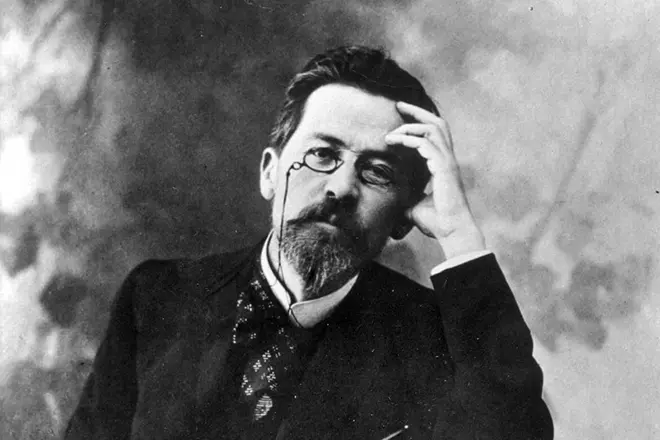
Anton Chekhov studied in the Taganrog gymnasium, when his father escaped from creditors to Moscow. The future writer remained in his hometown to graduate. He lived together with the new owners of his home home, paying his stay in it by tutoring.
Chekhov shaped their vision of the world, developed the love of books and the theater, while he was a gymnasium. In those years, Anton Pavlovich wrote several first humorous stories. From 13 years he adored the theater and even took part in the formulation of domestic performances of his gymnasium comrades.
Creation
The first printed work of Anton Pavlovich appeared in 1880 in the journal "Dragonfly". Since that time, Chekhov constantly collaborated with the magazines "Alarm Clock", "Spectator", "Mireskoy", "Light and Shadows". In the periodic edition of the "fragments" were first printed by many humorous Chekhov stories. In 1883, in the above magazine, the work "Fat and Slim" was published, in 1884 - "Chameleon", and in 1885 - "Pererap".
In 1886, a Christmas story "Vanka" was published in the Periodic Publication "Petersburg newspaper". The writer signed his first works by the pseudonym "Antosha Chekhonte".
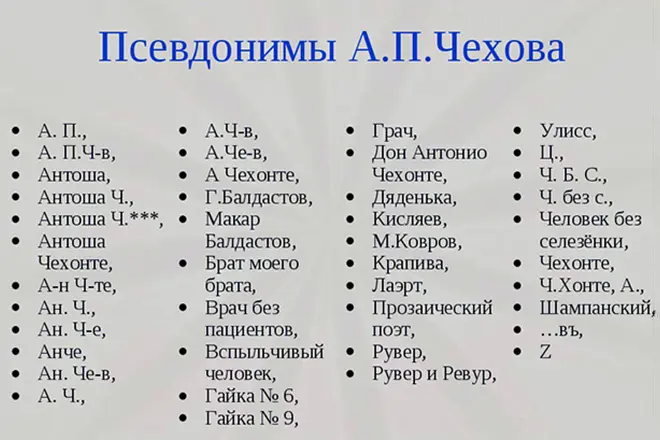
In 1886, Anton Pavlovich received a letter from St. Petersburg with a proposal for work. He was invited to the newspaper "New Time". During this period of time, the writer created collections "Mottle stories" and "innocent speeches". His works were popular, and Czech began to sign them in the present name.
The premiere of the first plays of Anton Pavlovich "Ivanov" was held in 1887 in Moscow. The essay of the novice playwright was set in the theater of the Korah. The reaction of the public was diverse, but the statement was successful. In the future, the play was put in St. Petersburg, in a slightly finalized form. In 1888, Anton Pavlovich was awarded the half Pushkin Prize for the collection of stories "at dusk".
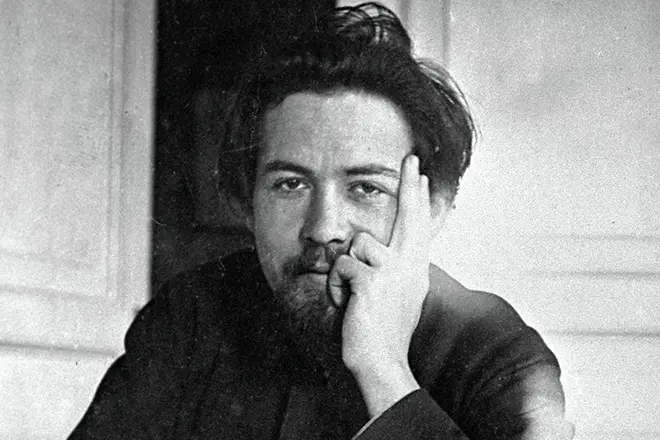
Summer 1888 and 1889 Chekhov spent in the Kharkiv province near Sumy. The death of one of the brothers forced the writer to escape from the places where he lived with relatives. Anton Pavlovich was going to Europe, but fate threw him in Odessa, where the Small Theater was toured. The writer became interested in one young actress, but the sympathy is quickly outlived. Feeling an attack of apathy, Chekhov went to Yalta.
By 1889, the writer was written to the story "Drama on the hunt", "steppe", "lights" and "boring history". The material for these works of Czechs collected on travels. Interest in visits to different seats appeared by the author in the late eighties, when he stopped cooperation with humorous journals.
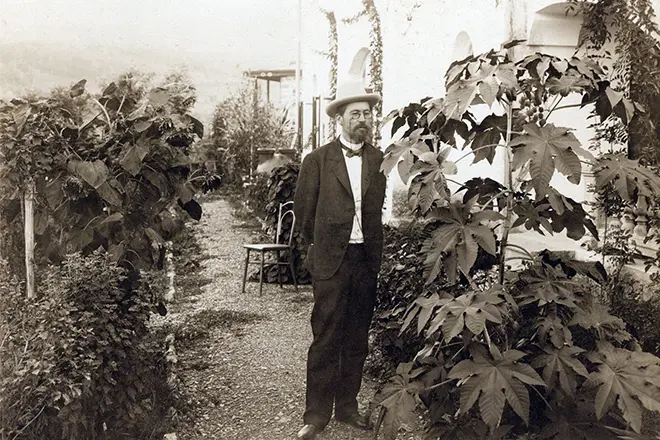
The desire to travel prompted Chekhov to go to Sakhalin in 1890. The road to the island lay through Siberia, where the writer is a stockpad material for its future literary projects. Considering the state of the health of a cachotochny patient, the trip was not easy for him. From the journey Chekhov brought a collection of essays "in Siberia" and the book "Sakhalin Island".
Many fans of Czech's creativity from all his works are particularly memorized by the story "Chamber No. 6". For the first time, she was published in the magazine "Russian Thought" in 1892. The name of the story was a meaningful thing, they designate something abnormal or crazy. Many expressions from this book went to quotes.
In 1892, the writer carried out his long-standing dream and bought the estate in Melikov. There he transported parents and sister Maria, who became the faithful keeper of his brother. After the acquisition of the estate, Chekhov was transformed. He again had the opportunity to do medical practice, after all, in addition to the literature, Anton Pavlovich had another passion - surgery.
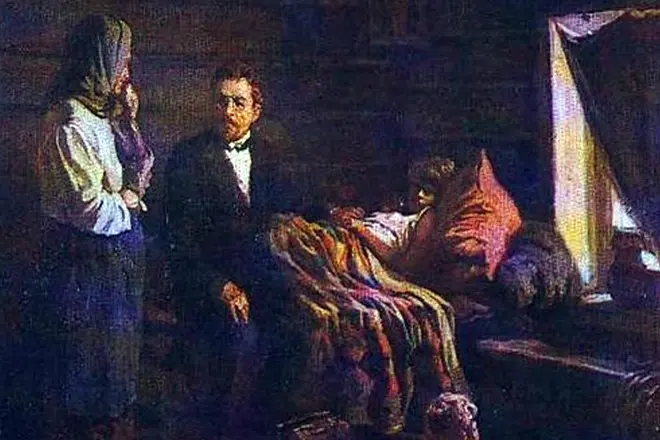
In the Melikhovsky period of Chekhov worked as a Zemsky doctor, built several schools, the fireplace for the peasants, the bell tower. The writer took care of the laying road on the burden and the appearance at the railway station of the post office. In addition, Czechs sentenced the weell forests of knitting, oaks, larchs and landed more than a thousand cherry trees. During this period, Anton Pavlovich also opened a public library in Taganrog.
Many famous works of Chekhov were written in the estate. Pieces "Chaika" and "Uncle Vanya" were from Melikovo. The exacerbation of tuberculosis forced the writer often to leave the estate, leaving south. In the winter of 1898, the playwright spent in Nice, and after returning from France, I bought a plot of land in Yalta. In the summer of 1899, Chekhov sold the estate and finally moved to the Crimea.
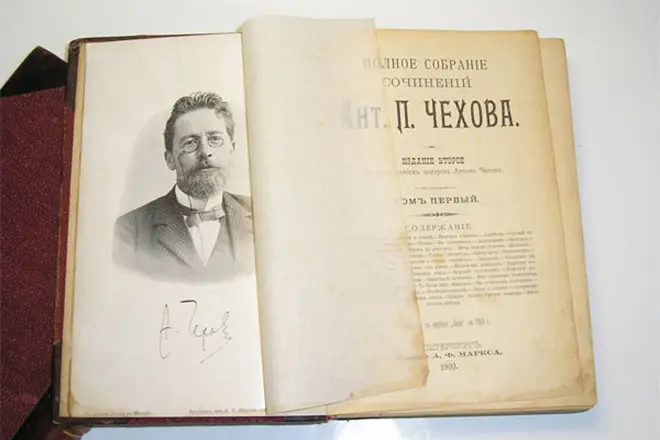
During this period of his life, Anton Pavlovich met the future wife. July 1900 Olga Bookper spent at the cottage in Chekhov, which determined the course of their further relations. In 1900, the playwright created the "Three Sisters" play in which his spouse played brilliantly. The success of Olga Knipper as the performer of the main women's role in Chekhov's plays was repeated and during the production of the work of the "Cherry Garden" in 1903.
In 1904, the playwright died. Piece "Cherry Garden" has become the last work of the Russian classic.
Performances and movies
Soviet director Sergey Yutkevich took a film about creating a play "Seagull". The tape received the name "plot for a small story."Robert Long and Dmitry Frenkel, using the facts from the biography of the writer, in 1991 put in the Netherlands the musical performance "Chekhov".
Biographical drama "Forgive, Dr. Chekhov!" The life of the playwright was removed on the request of the Government of Moscow in 2007.
In 2012, a film was released, talking about Anton Pavlovich and Lydia Avilova's relations. In the picture called "Fans", famous Russian actors Oleg Tabakov and Kirill Piragi starred.
In 2015, French director Renee Ferr on his own scenario shot Anton Chekhov 1890 tape. The role of Russian playwright performed a young actor Nicolas Zhiro. The plot of the film is built around the life of the writer from 1885 to 1890.
Personal life
Personal life of the writer is replete with love stories. Chekhov's relations with his passions lasted years. Writer's novels did not happen alternately. His women often knew about each other, but did not hurry to break the connection with the beloved.
In 1888, the writer became interested in Lydia Mysina. A nineteen-year-old girl was a girlfriend of Sisters Chekhov. Lick Mizinov really wanted to be a writer's wife, and he wanted to be free and independent. As a spouse, the girl was not interested in him. It did not prevent Chekhov for almost ten years to give beauty hope. He enjoyed her by society, but avoided conversations about marriage and joint economy.
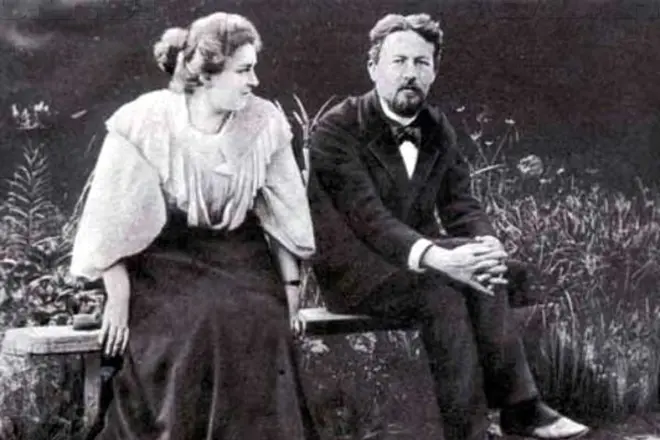
The first few years of communication with the face of Chekhov ridiculed possible rivals in her presence, depriving potential workers chances to get the location of the young lady. Later, Anton Pavlovich himself introduced the lick in love with Lovelas Ignatius Potapenko.
Mizinova entered into contact with a married fan, got pregnant and gave birth to a daughter. The child died in the first years of life. Czechs used these facts and made Mysine the prototype of Nina Zarechny from the "Seagull". After complex and tangled games with Chekhov and Potapenko, the face found a consolation in marriage. In 1902, she married the theater director Alexander Sanina.
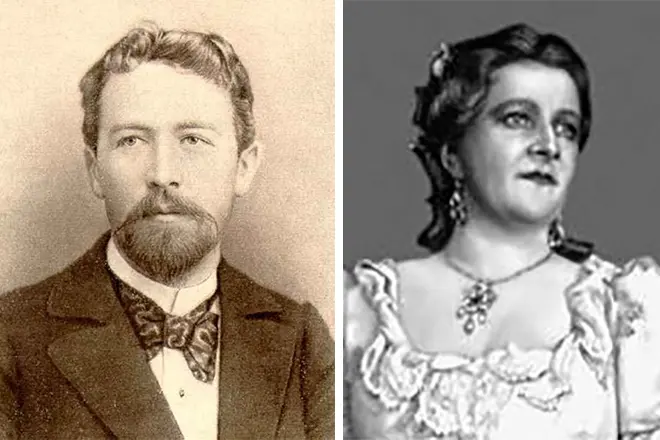
In the eighties of the nineteenth century, Anton Pavlovich became acquainted with Elena Shavarov. The fifteen-year-old girl brought Chekhov's manuscript of his story and fell in love with a writer without memory. The girl understood that there was little chances for reciprocity, and five years after their meeting married.
In 1897, she arrived visiting relatives to Moscow. They met with Chekhov, and a novel happened between them. Lovers escaped to the Crimea. In Yalta, they spent some time together, but broke up. Chekhov wrote Elena about seven dozen letters, more than any of his beloved. Anton Pavlovich prescribed the image of Shavarov in the story "Lady with a dog".
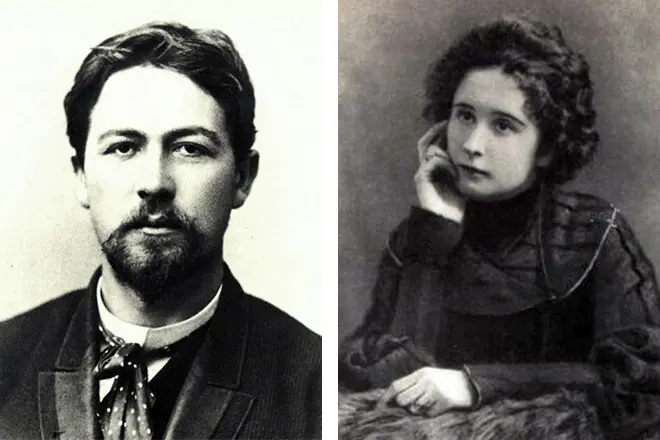
In 1898, at the premiere of Pieces "Chaika" met the playwright his old familiar Nino Korsh. She was in love with Chekhov from twelve years and did not miss the chance to try his spell on the writer. Anton Pavlovich got carried away. The result of this passion was the pregnancy of Nina. It is believed that the writer has no direct descendants, but in 1900 he had a daughter of Tatyana. Chekhov did not know about this circumstance, as he gave Nina resignation due to the novel with Olga Knipper. Korsh did not tell the writer about pregnancy. After birth, Nina's daughter with her parents left for Paris. Tatyana Antonovna became a doctor, going at the footsteps of the Father.
Olga Bookper turned out to be the woman who was able to convince Chekhov to marry her. They met in 1898 on one of the rehearsals of the play "Seagull". Olga was a beautiful and charming woman, actress. In 1901, lovers were married. There were no children from the pair. The book was pregnant, but the heir was not born.
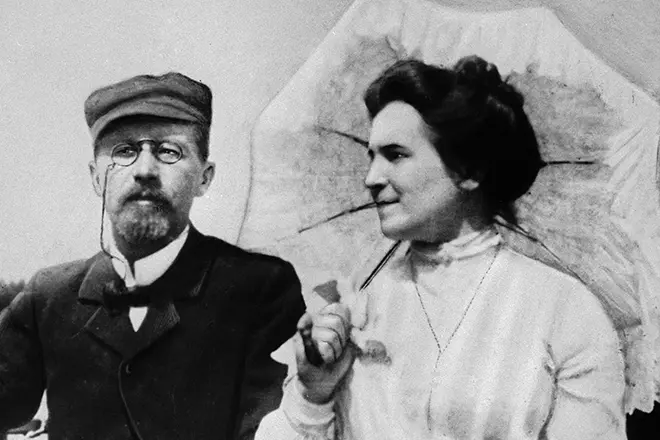
Letters from the archive of Chekhov leave a dual impression of the success of his union with a book. Olga did not leave the scene, and Czechs almost constantly lived in Yalta, tamping the frequent attacks of tuberculosis. The love story of the writer and his wife began with mutual feelings and beautiful courtesies, but turned into an epistolary novel with rare meetings.
Friends Chekhov believed that if the writer did not marry Olga, he would have lived a longer and happy life. This story, this story turned out not so dramatic as it could be. In the last days of the life of the playwright, the wife was next to him, and not on tour.
Disease and death
Chekhov was sick with tuberculosis. The first time he found signs of consumers aged 24 years. His malaise since 1885 became more obvious, the temperature was accompanied by a bloody cough, as evidenced by the memories of the writer. In his youth, Anton Pavlovich was not treated from tuberculosis. It seemed to him that the symptoms belong to other illness.
Later, the writer hid his bad well-being from loved ones and native people. He did not want to disturb his sister and mother. By 1897, the playwright was already very seriously ill, he regularly had bleeding from the right lung. This fact made him get a survey under the supervision of Professor Ostrumov.
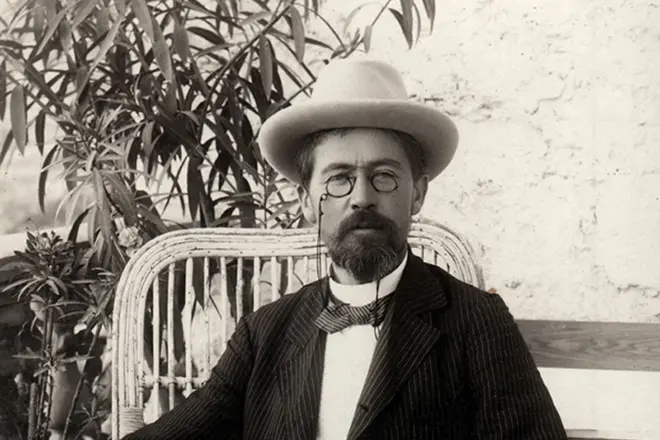
To study the symptoms of Chekhov's disease, he was laid in the hospital. Doctors diagnosed, prescribed treatment. As soon as the writer has become better, he began to ask home. Chekhov really wanted to continue his literary activities. In 1898, the attacks of the bloody cough began to stretch from Chekhov for several days. He hid this fact from his relatives.
The painful sensations that became an integral life of Chekhov, the writer endowed his heroes. This transfer is most noticeable in the work of the story of an unknown person.
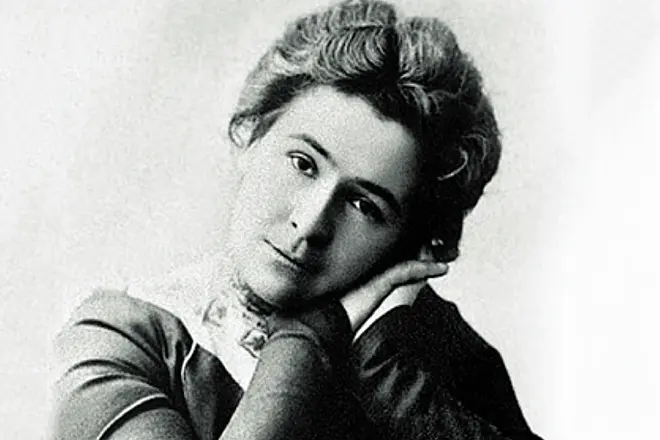
The writer was prescribed visits to various resorts, the road to which was sometimes too heavy for a sick person. Stay in Yalta extended life to the writer until he married. Ivan Bunin believed that the spouse was undermined by Anton Pavlovich's health with his frequent departures. She did not get along with the beloved sister of the writer Maria, adding a spouse of reasons for excitement. Shortly before the death of Chekhov and his wife went to the resort in South Germany.
In the summer of 1904, a writer died in Badenvaler. The cause of the death of Chekhov - tuberculosis. It all started with the fact that the playwright felt worse than usual. When his bed had a doctor, Chekhov already told that he dies. He asked him to file champagne, drank a glass and died.
Interesting Facts
- In childhood, Chekhov was called "Bomb", because he had a big head. Together with the brothers, he sang in the church choir, who led his father.
- The writer did not always sign his works of this last name. More than four dozen pseudonyms Anton Pavlovich are known to literary critic.
- The writer loved dogs. He held two dachshunds. The playwright named Khaina Markovna and Bromine Isaevich in honor of popular medicines. The writer also kept in the mangoste's house.
- The playwright was friendly with Peter Tchaikovsky, Maxim Gorky, Isaac Levitan, Ivan Bunin, and Lion Tolstoy called his idol.
- Anton Pavlovich was tall above 180 centimeters. His charm attracted a large number of women. Friends of the playwright in a joke called them "Antonovkov".
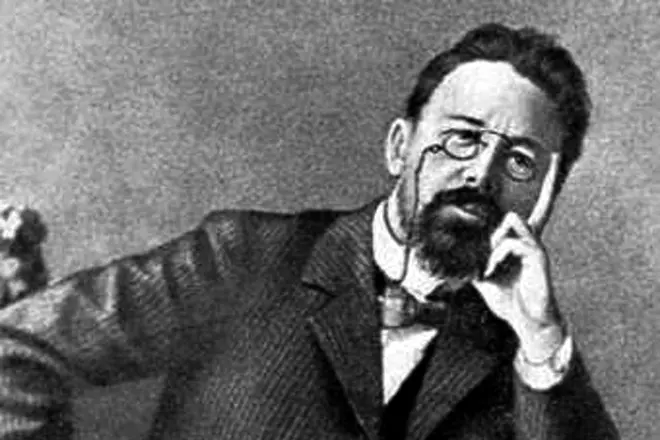
- The coffin with the body of the writer was taken to Moscow from Germany in a car with the inscription "Oysters". It was the only part of the composition equipped with refrigerator cabinets.
- After the death of the writer, one of his acquaintances on literary activities issued memoirs "A. P. Chekhov in my life. " Lydia Avilova argued that serious passions were played between her and the writer, although the documentary evidence of this version does not exist. In his letters, Anton Pavlovich turned to her "Mother" or "Multivaable". Lydia Avilova explained this to the fact that he burned most of the intimate correspondence with the playwright.
- Historians doubt the truthfulness of her memoirs, believing that the writer wanted to attract attention with the help of the name of the famous colleague.
